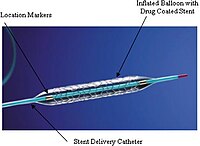
The impact of diabetes on the prognostic value of left ventricular function following percutaneous coronary intervention: Insights from the British Cardiovascular Intervention Society
Sign Up to like & getrecommendations! Published in 2018 at "Catheterization and Cardiovascular Interventions"
DOI: 10.1002/ccd.27642
Abstract: To study the relationship between diabetes mellitus (DM) and left ventricular (LV) function on outcomes following percutaneous coronary intervention (PCI). read more here.
Keywords: intervention; following percutaneous; ventricular function; percutaneous coronary ... See more keywords

Radiographic hemithorax white-out following percutaneous nephrolithotomy
Sign Up to like & getrecommendations! Published in 2018 at "Urology Case Reports"
DOI: 10.1016/j.eucr.2017.12.002
Abstract: Percutaneous nephrolithotomy (PCNL) is a safe and effective treatment for renal stones and is the first-line treatment modality for stone burdens greater than 20mm. Respiratory complications during PCNL are generally associated with surgical technique leading… read more here.
Keywords: following percutaneous; white following; radiographic hemithorax; hemithorax white ... See more keywords

Optimal duration and combination of antiplatelet therapies following percutaneous coronary intervention: A systematic review and meta-analysis.
Sign Up to like & getrecommendations! Published in 2021 at "Vascular pharmacology"
DOI: 10.1016/j.vph.2021.106858
Abstract: INTRODUCTION The ideal duration of dual antiplatelet therapy (DAPT) following percutaneous coronary intervention (PCI) is still unknown. In this meta-analysis, we aimed to compare very short-term (1-3 months), short-term (6 months), standard-term (12 months) and long-term (>12 months) DAPT… read more here.
Keywords: following percutaneous; risk; term; term dapt ... See more keywords

Acute kidney injury following percutaneous left atrial appendage occlusion: results from an international multicentre registry
Sign Up to like & getrecommendations! Published in 2023 at "Europace"
DOI: 10.1093/europace/euad122.214
Abstract: Abstract Funding Acknowledgements Type of funding sources: None. Background Acute kidney injury (AKI) is a serious complication after invasive cardiac procedures and has been associated with a higher incidence of periprocedural complications and increased mortality.… read more here.
Keywords: aki; serum creatinine; following percutaneous; increase ... See more keywords

Outcomes following percutaneous coronary revascularization among South Asian and Chinese Canadians
Sign Up to like & getrecommendations! Published in 2017 at "BMC Cardiovascular Disorders"
DOI: 10.1186/s12872-017-0535-0
Abstract: BackgroundPrevious data suggest significant ethnic differences in outcomes following percutaneous coronary revascularization (PCI), though previous studies have focused on subgroups of PCI patients or used administrative data only. We sought to compare outcomes in a… read more here.
Keywords: following percutaneous; coronary revascularization; days years; outcomes following ... See more keywords

Value of preoperative urine white blood cell and nitrite in predicting postoperative infection following percutaneous nephrolithotomy: a meta-analysis.
Sign Up to like & getrecommendations! Published in 2021 at "Translational andrology and urology"
DOI: 10.21037/tau-20-930
Abstract: Background To evaluate to what degree preoperative urine white blood cell (WBC) and urine nitrite (NIT) values are predictive of postoperative infections following percutaneous nephrolithotomy (PCNL). Methods A systematic literature search was performed of the… read more here.
Keywords: blood cell; white blood; preoperative urine; following percutaneous ... See more keywords

Clinical features and management of seizure following percutaneous endoscopic spine surgery: A retrospective case series analysis.
Sign Up to like & getrecommendations! Published in 2022 at "World neurosurgery"
DOI: 10.2139/ssrn.4163465
Abstract: OBJECTIVE To describe the perioperative clinical features, management, and outcomes of patients with seizure following percutaneous endoscopic spine surgery (PESS). METHODS Patients who experienced seizure following PESS in an tertiary orthopaedic hospital between January 2016… read more here.
Keywords: seizure; features management; following percutaneous; seizure following ... See more keywords

Predictors of restenosis following percutaneous coronary stent implantation: The role of trimetazidine therapy
Sign Up to like & getrecommendations! Published in 2022 at "Frontiers in Cardiovascular Medicine"
DOI: 10.3389/fcvm.2022.873899
Abstract: Aims In-stent restenosis (ISR) is an unresolved problem following percutaneous coronary intervention (PCI), having a negative impact on clinical outcome. The main goal of this study was to find new independent predictors that may influence… read more here.
Keywords: stent implantation; percutaneous coronary; isr; following percutaneous ... See more keywords

Duration and clinical outcomes of dual antiplatelet therapy following percutaneous coronary intervention for acute coronary syndrome: A multicentre “real-world practice” registry-based study
Sign Up to like & getrecommendations! Published in 2023 at "Frontiers in Cardiovascular Medicine"
DOI: 10.3389/fcvm.2023.1158466
Abstract: Background The optimal duration of dual antiplatelet therapy (DAPT) ought to be determined taking into account individual ischaemic or bleeding events risks. To date, studies have provided inconclusive evidence on the effects of prolonged DAPT.… read more here.
Keywords: coronary syndrome; following percutaneous; acute coronary; antiplatelet therapy ... See more keywords

Incidence and implications of silent hydronephrosis following percutaneous nephrolithotomy .
Sign Up to like & getrecommendations! Published in 2017 at "Clinical nephrology"
DOI: 10.5414/cn108926
Abstract: OBJECTIVE While routine renal imaging following ureteroscopy for urinary calculi has been recommended to screen for asymptomatic "silent" obstruction, the rate of silent obstruction following percutaneous nephrolithotomy (PCNL) remains poorly defined, and no consensus recommendations… read more here.
Keywords: following percutaneous; obstruction; stone; silent hydronephrosis ... See more keywords